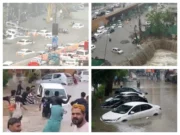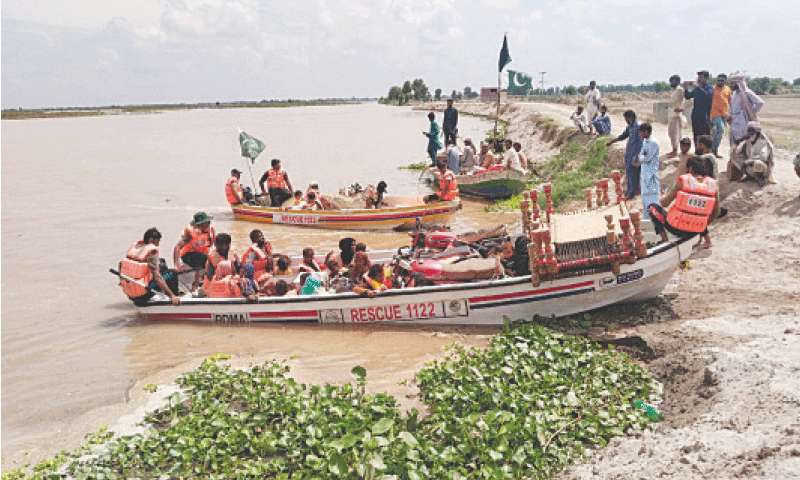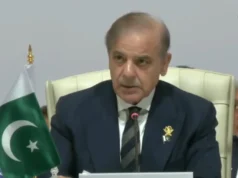LAHORE/ISLAMABAD — Pakistan has deployed troops to six districts of Punjab province after sudden releases of water from India’s upstream dams, combined with heavy monsoon rains and accelerated glacial melt, triggered a severe flood emergency. Authorities warn that the next 72 hours are critical, with nearly 200,000 people already evacuated from vulnerable areas.
India’s Dam Releases Compound Crisis
Officials in Lahore confirmed that India had opened all gates of the Thein (Ranjit Sagar) Dam on the Ravi, releasing around 77,000 cusecs, just days after discharging water from the Madhopur Dam. Additional outflows from the Pong and Bhakra dams in Himachal Pradesh have swollen the Sutlej River, pushing levels close to record highs.
The sudden discharges have inundated downstream areas in Pakistan where rivers are already swollen from relentless rains. Officials said the Ravi River poses the greatest risk, since much of its bed in Pakistan remains dry for most of the year, leaving communities unprepared for sudden torrents.
“The uncoordinated release of water from across the border has magnified the destruction,” one Punjab irrigation official said.
Rivers at Breaking Point
- Chenab at Head Marala: Surged beyond 900,000 cusecs, classified as “exceptionally high flood.”
- Ravi at Head Jassar: Exceeded 200,000 cusecs, also “exceptionally high.”
- Head Khanki (Chenab): Reached 426,578 cusecs — “very high flood.”
- Sutlej at Ganda Singh Wala: Recorded 245,236 cusecs, nearing “catastrophic” levels.
In Kasur district alone, 72 villages and more than 45,000 residents have been affected, while flooding in the Sutlej basin has hit Pakpattan, Vehari, Bahawalnagar, and Bahawalpur.
Army Deployed, Mass Evacuations Ordered
The army has been requisitioned in Lahore, Faisalabad, Kasur, Sialkot, Narowal, and Okara to support rescue and relief operations. Rescue 1122 said it has evacuated 28,000 people so far, while PDMA reported relocation of 14,000 citizens and 17,000 livestock.
Relief agencies have established 67 relief camps, 38 medical camps, and 46 veterinary centres, supported by boats, motors, and tents.
Prime Minister Shehbaz Sharif chaired an emergency meeting, ordering expedited evacuations, immediate supply of food and medicines, and restoration of disrupted power and communication lines.
Climate and Geopolitics Intertwined
NDMA Chairman Lt Gen Inam Haider Malik told lawmakers that 45 percent of Pakistan’s glaciers are melting at an accelerated pace, warning that unchecked melting, coupled with unpredictable upstream releases, could undermine the country’s water security.
He projected that next year’s monsoon could be 22 percent more intense, compounding the crisis. Pakistan has already lost more than 800 lives to floods this monsoon season, with nearly half the deaths recorded in August alone.
Punjab Irrigation Minister Kazim Raza Pirzada stressed that the eastern rivers are overwhelmed by both glacial melt and India’s discharges. “Catchment areas are receiving heavier and more intense rainfall bursts than in the past,” he said.
‘Pakistan Cannot Face This Crisis Alone’
Despite contributing less than 1 percent to global carbon emissions, Pakistan remains among the most climate-vulnerable nations. Sharif appealed for international support, warning: “The devastating floods of 2022 and the loss of over 700 lives due to extreme weather events this year alone are stark reminders that Pakistan cannot face this crisis alone.”
With more rain forecast until mid-September, and both India’s dam releases and monsoon downpours continuing to swell the rivers, authorities warn the next few days will determine the fate of Punjab’s flood defenses.
“The flood situation is grave,” NDMA’s Haider said. “The next 48 to 72 hours will be decisive. We urge the public to remain vigilant and cooperate with authorities.”



































